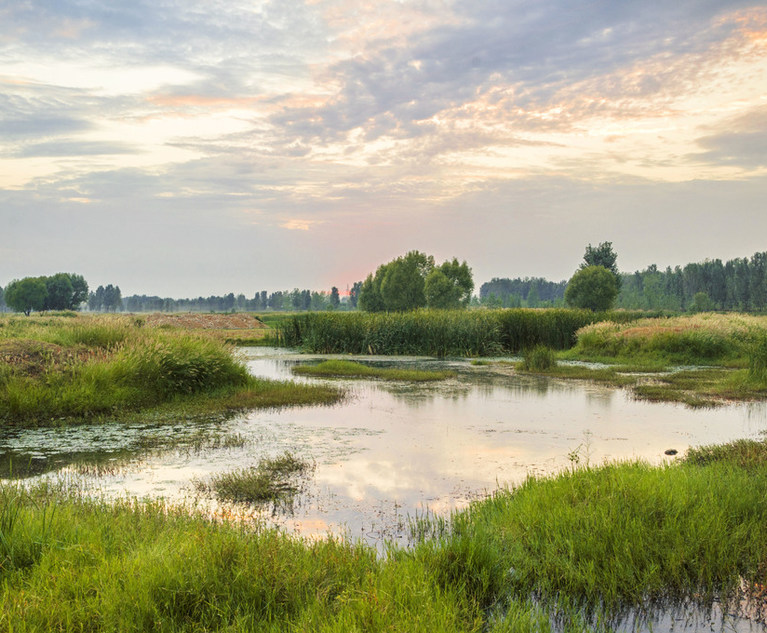Supreme Court Weighs Wetlands Protection; New York State's Wetlands Valuation
The Supreme Court, in 'Sackett v. U.S. Environmental Protection Agency', will decide on whether the Ninth Circuit set forth the proper test for determining whether wetlands are "waters of the United States" under the Clean Water Act.
October 24, 2022 at 09:30 AM
8 minute read
 On Oct. 3, 2022, the Supreme Court heard argument in Sackett v. U.S. Environmental Protection Agency, ___ U.S. ___ (No. 21-454). The Sacketts bought their land in 2004 in a subdivision near Priest Lake, Idaho. They obtained the necessary permits to build a modest three-bedroom family home. In 2007 they began construction only to have EPA officials demand they stop, alleging that their land was protected wetlands under federal jurisdiction. The EPA's compliance order claimed the construction violated the Clean Water Act (CWA) because their property was a federally regulated "navigable water."
On Oct. 3, 2022, the Supreme Court heard argument in Sackett v. U.S. Environmental Protection Agency, ___ U.S. ___ (No. 21-454). The Sacketts bought their land in 2004 in a subdivision near Priest Lake, Idaho. They obtained the necessary permits to build a modest three-bedroom family home. In 2007 they began construction only to have EPA officials demand they stop, alleging that their land was protected wetlands under federal jurisdiction. The EPA's compliance order claimed the construction violated the Clean Water Act (CWA) because their property was a federally regulated "navigable water."
In earlier litigation, the Sacketts won the right to challenge the EPA's order in a court of law. When their litigation simply languished in lower courts, the Sacketts' counsel, the Pacific Legal Foundation, returned to the Supreme Court asking the court to clarify the scope of the EPA's regulatory powers under the CWA. At stake is whether the EPA can expand the definition of "navigable waters"—which limits their authority to include any semi-soggy parcel of land.
The question presented in petitioners' brief is: "Did the Ninth Circuit set forth the proper test for determining whether wetlands are 'waters of the United States' under the Clean Water Act, 33 U.S.C. §1362(7)?"
This content has been archived. It is available through our partners, LexisNexis® and Bloomberg Law.
To view this content, please continue to their sites.
Not a Lexis Subscriber?
Subscribe Now
Not a Bloomberg Law Subscriber?
Subscribe Now
NOT FOR REPRINT
© 2025 ALM Global, LLC, All Rights Reserved. Request academic re-use from www.copyright.com. All other uses, submit a request to [email protected]. For more information visit Asset & Logo Licensing.
You Might Like
View All

Judgment of Partition and Sale Vacated for Failure To Comply With Heirs Act: This Week in Scott Mollen’s Realty Law Digest

Artificial Wisdom or Automated Folly? Practical Considerations for Arbitration Practitioners to Address the AI Conundrum
9 minute readLaw Firms Mentioned
Trending Stories
- 1AIAs: A Look At the Future of AI-Related Contracts
- 2Litigators of the Week: A $630M Antitrust Settlement for Automotive Software Vendors—$140M More Than Alleged Overcharges
- 3Litigator of the Week Runners-Up and Shout-Outs
- 4Linklaters Hires Four Partners From Patterson Belknap
- 5Law Firms Expand Scope of Immigration Expertise, Amid Blitz of Trump Orders
Who Got The Work
J. Brugh Lower of Gibbons has entered an appearance for industrial equipment supplier Devco Corporation in a pending trademark infringement lawsuit. The suit, accusing the defendant of selling knock-off Graco products, was filed Dec. 18 in New Jersey District Court by Rivkin Radler on behalf of Graco Inc. and Graco Minnesota. The case, assigned to U.S. District Judge Zahid N. Quraishi, is 3:24-cv-11294, Graco Inc. et al v. Devco Corporation.
Who Got The Work
Rebecca Maller-Stein and Kent A. Yalowitz of Arnold & Porter Kaye Scholer have entered their appearances for Hanaco Venture Capital and its executives, Lior Prosor and David Frankel, in a pending securities lawsuit. The action, filed on Dec. 24 in New York Southern District Court by Zell, Aron & Co. on behalf of Goldeneye Advisors, accuses the defendants of negligently and fraudulently managing the plaintiff's $1 million investment. The case, assigned to U.S. District Judge Vernon S. Broderick, is 1:24-cv-09918, Goldeneye Advisors, LLC v. Hanaco Venture Capital, Ltd. et al.
Who Got The Work
Attorneys from A&O Shearman has stepped in as defense counsel for Toronto-Dominion Bank and other defendants in a pending securities class action. The suit, filed Dec. 11 in New York Southern District Court by Bleichmar Fonti & Auld, accuses the defendants of concealing the bank's 'pervasive' deficiencies in regards to its compliance with the Bank Secrecy Act and the quality of its anti-money laundering controls. The case, assigned to U.S. District Judge Arun Subramanian, is 1:24-cv-09445, Gonzalez v. The Toronto-Dominion Bank et al.
Who Got The Work
Crown Castle International, a Pennsylvania company providing shared communications infrastructure, has turned to Luke D. Wolf of Gordon Rees Scully Mansukhani to fend off a pending breach-of-contract lawsuit. The court action, filed Nov. 25 in Michigan Eastern District Court by Hooper Hathaway PC on behalf of The Town Residences LLC, accuses Crown Castle of failing to transfer approximately $30,000 in utility payments from T-Mobile in breach of a roof-top lease and assignment agreement. The case, assigned to U.S. District Judge Susan K. Declercq, is 2:24-cv-13131, The Town Residences LLC v. T-Mobile US, Inc. et al.
Who Got The Work
Wilfred P. Coronato and Daniel M. Schwartz of McCarter & English have stepped in as defense counsel to Electrolux Home Products Inc. in a pending product liability lawsuit. The court action, filed Nov. 26 in New York Eastern District Court by Poulos Lopiccolo PC and Nagel Rice LLP on behalf of David Stern, alleges that the defendant's refrigerators’ drawers and shelving repeatedly break and fall apart within months after purchase. The case, assigned to U.S. District Judge Joan M. Azrack, is 2:24-cv-08204, Stern v. Electrolux Home Products, Inc.
Featured Firms
Law Offices of Gary Martin Hays & Associates, P.C.
(470) 294-1674
Law Offices of Mark E. Salomone
(857) 444-6468
Smith & Hassler
(713) 739-1250







